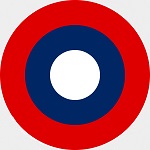Wings of the Great War WW15001 U.S. Air Service Spad XIII Biplane Fighter - 1st Lt. Eddie Rickenbacker, 94th Aero Squadron, April 1918 (1:72 Scale)
"Courage is doing what you are afraid to do. There can be no courage unless you are scared."
- Eddie Rickenbacker
 The SPAD S.XIII was a French biplane fighter aircraft of World War I, developed by Socit Pour L'Aviation et ses Drivs (SPAD) from the earlier highly successful SPAD S.VII. It was one of the most capable fighters of the war, and one of the most-produced, with 8,472 built and orders for around 10,000 more cancelled at the Armistice.
The SPAD S.XIII was a French biplane fighter aircraft of World War I, developed by Socit Pour L'Aviation et ses Drivs (SPAD) from the earlier highly successful SPAD S.VII. It was one of the most capable fighters of the war, and one of the most-produced, with 8,472 built and orders for around 10,000 more cancelled at the Armistice.
The SPAD XIII was standardized by the Aronautique Militaire as the equipment of its own escadrilles de chasse (fighter squadrons) for 1918. The SPAD was also the first choice of the United States Air Service - however a shortage of SPADs led to the available production Nieuport 28s equipping four American squadrons between March and August 1918. It thus became the first aircraft to see operational service with an American fighter squadron.
The SPAD S.VII was a single-seat fighter aircraft powered by a 150 horsepower (110 kW) Hispano-Suiza 8A water cooled V-8 engine and armed with a single synchronised Vickers machine gun. It demonstrated excellent performance for the time, and entered service with the French Aronautique Militaire in August 1916. By early 1917, however it had been surpassed by the latest German fighters, leading French flying ace Georges Guynemer to lobby for an improved version telling the SPAD designer Louis Bchereau that "The 150 hp SPAD is not a match for the Halberstadt ... More speed is needed." An initial solution was to increase the compression ratio of the Hispano-Suiza engine, increasing its power to 180 hp (130 kW), which gave significantly improved performance, allowing the SPAD S.VII to remain competitive, but Hispano-Suiza were developing a geared version of the 8A engine, which would produce greater power, and this engine was chosen by Bchereau for two new fighter aircraft. First to fly was the S.XII, armed with a 37 mm cannon firing through the propeller shaft. This saw limited use, but was followed into production by the more conventionally armed S.XIII.
Pictured here is a 1:72 scale replica of a french-built U.S. Air Service Spad XIII biplane fighter that was piloted by 1st Lt. Eddie Rickenbacker, who was attached to the 94th Aero Squadron.
Now in stock!
Dimensions:
Length: 4-inches
Wingspan: 5-inches
Release Date: November 2014
 Historical Account: "Hat in the Ring" - Edward Vernon Rickenbacker (October 8th, 1890 - July 27th, 1973) was an American fighter ace in World War I and Medal of Honor recipient. He was also a race car driver and automotive designer, a government consultant in military matters and a pioneer in air transportation. During his lifetime, Rickenbacker worked with many influential civilian and military leaders. He had keen insight into technology, and vision for future improvements. Among other events, he participated in or observed Armistice Day on the Western Front.
Historical Account: "Hat in the Ring" - Edward Vernon Rickenbacker (October 8th, 1890 - July 27th, 1973) was an American fighter ace in World War I and Medal of Honor recipient. He was also a race car driver and automotive designer, a government consultant in military matters and a pioneer in air transportation. During his lifetime, Rickenbacker worked with many influential civilian and military leaders. He had keen insight into technology, and vision for future improvements. Among other events, he participated in or observed Armistice Day on the Western Front.
Rickenbacker demonstrated that he had a qualified replacement, and the military awarded him a place in America's second air-combat squadron, the 94th Aero Squadron, informally known as the 'Hat-in-the-Ring' Squadron. He initially flew the Nieuport 28, sometimes without weaponry, alongside French pilots. The 94th periodically faced Germany's legendary Flying Circus, led by the Red Baron, Manfred von Richthofen, until von Richthofen's death in combat. On April 21st, 1918, Rickenbacker shot down his first plane. During WWI, he and the other pilots developed important aviation principles that would serve them in civil aviation and in World War II combat.


